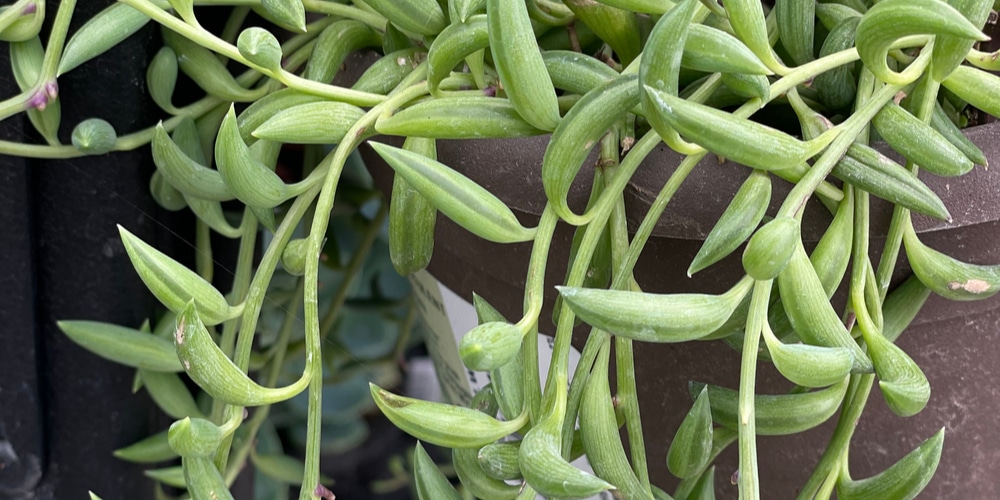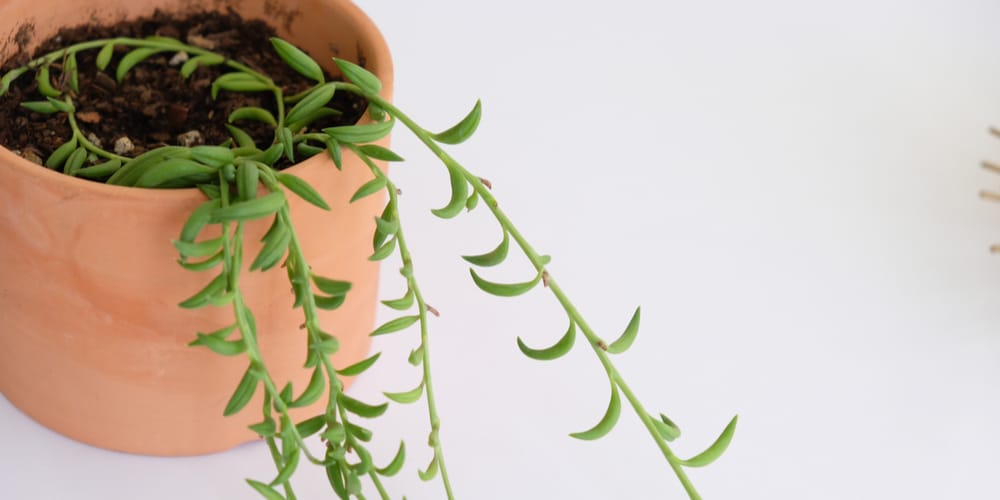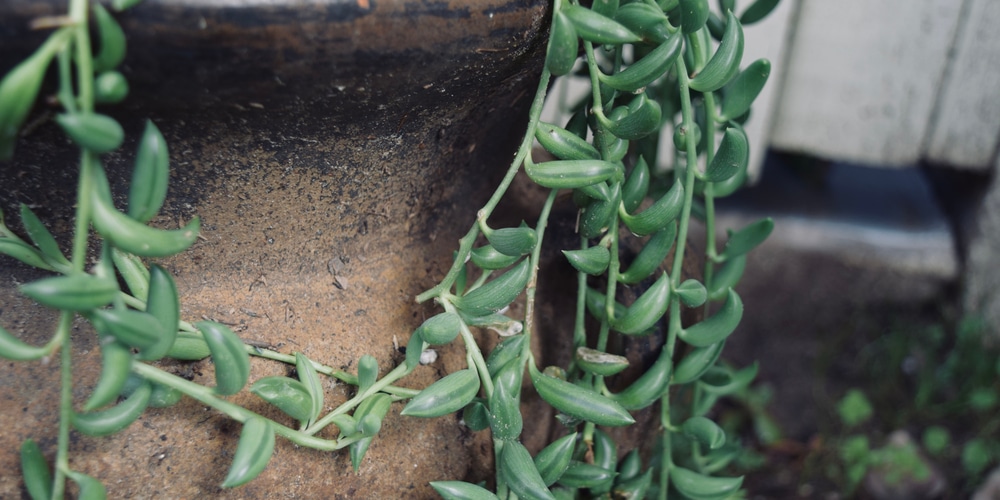Native to South Africa, string of bananas or curio radicans is a beautiful, trailing succulent that’s perfect for hanging baskets. The plant gets its name from its long, banana-shaped leaves that are arranged in a rosette pattern.
While similar in nature to the string of pearls, the string of bananas is easier to care for and maintain. It’s also faster growing in nature, making it an ideal choice for those who want instant gratification.
Characterized by its glossy green leaves, tendrils, and flowers, the string of bananas is a stunning addition to any indoor or outdoor space. If you’re looking for a plant that’s both low maintenance and eye-catching, this is the one for you.
| Botanical Name | Curio Radicans |
| Common Name | String of Bananas, Banana Vine |
| Plant Type | Perennial |
| Flower Color | Light pink, white |
| Size When Mature | 36 inches in length |
| Bloom Time | Spring |
| Sun Requirements | Full sun, tolerates partial sun |
| USDA Hardiness Zones | 10 – 12 |
| Soil PH Range | 6.6 – 7.5 |
| Soil Type | Succulent soil, well-draining, neutral to alkaline |
| Water Needs | Medium |
| Native Area | South Africa |
What You Need to Know About String of Bananas
Beautifully trailing and bearing resemblance to a string of pearls, string of bananas (curio radicans) is native to South Africa. As a fast-growing succulent, it’s perfect for filling hanging baskets or brightening up a windowsill.
Its foliage is what sets it apart from other plants in the Curio genus. The leaves are shaped like bananas and grow in a rosette pattern along the stems. The leaves are also slightly fleshy with a light green hue, often tinged with red or purple.
If you’ve tried growing and taking care of string of pearls, then you’ll have a good idea of what to expect with string of bananas. Both plants are in the Curio genus and have very similar care needs.
Its lush and vibrant green leaves make string of bananas a popular choice for those who want to add a touch of greenery to their home. The plant is also known for its fast growth rate, ideal for those who are new to plant care.
The plant produces small, white, or pinkish flowers that bloom in the spring and summer months. Its flowers have a sweet fragrance, often compared to that of vanilla.
If you don’t want this plant to trail downwards, you can use a trellis or other support system to help it grow upwards. This makes a perfect aesthetic choice for an indoor plant.
How to Care for String of Bananas
Here’s everything you need to know about growing and caring for a thriving string of bananas houseplant:
Light
Lavish in any well-lit location, the string of bananas is known to be a sun-loving plant. Make sure that it gets at least six hours of direct sunlight, making it a perfect addition to any outdoor garden.
If you’ve decided to pot and place it indoors, ensure that you position it near a sunny window. The more sun it gets, the lusher and fuller it will become. It’s important to note that too much direct sunlight can scorch the leaves, so be sure to give them some protection if needed.
Direct sunlight for prolonged periods can cause its lush leaves to lose their vibrancy. If this happens, simply move it to a shadier spot, or find a place on your windowsill that receives filtered light.
Water and Soil Needs
Watering string of bananas is a bit tricky, and this is probably one of the most challenging aspects of caring for this plant. It’s important to strike a balance, as too much or too little water can lead to problems.
The best way to water your string of bananas is to allow the soil to dry out completely between watering. Stick your finger about an inch into the soil to check. If it feels dry, give it a good soak, making sure that water drains out of the bottom of the pot. A good soak means that the water should be running out of the drainage holes.
If you notice that the leaves are wilting, it’s a sign that the plant is thirsty and needs to be watered immediately. On the other hand, if the leaves are turning yellow or brown, it means that you’re overwatering your plant.
This succulent is drought-tolerant and can store water in its leaves, so it can survive periods of dryness. However, it’s important to keep up with its watering needs to ensure that it stays healthy and happy.
The type of soil you use is also important for optimal growth. The string of bananas needs a well-draining potting mix, as it’s susceptible to root rot. A cactus or succulent potting mix would be ideal. Make sure that you get one of these from your local gardening store.
If you’re not sure whether your potting mix is well-draining, simply add some perlite or sand to improve drainage. You can also make your own potting mix by mixing two parts of peat moss with one part of perlite.
Although string of bananas would thrive in any soil pH, keeping it within the 6.6 – 7.5 pH range would be ideal.
Temperature Requirements
This tropical plant loves the heat and does best in warm temperature ranges. It’s important to keep your string of bananas in an area where the temperature stays above 50 degrees Fahrenheit. With that being said, it thrives in USDA zones 10 through 12, making it the perfect addition to any outdoor garden.
When bringing your plant indoors for the winter, make sure that you place it in a warm room. A cool basement or garage is not ideal, as the temperature in these areas can drop below 50 degrees Fahrenheit and cause your plant to go into shock.
Fertilizer
The best fertilizer to use on a string of bananas is a liquid fertilizer that’s high in potassium and low in nitrogen. This will help to promote growth and prevent the yellowing of the leaves.
You can fertilize your plant once a month during the growing season, which is typically from spring to fall. If you live in a warm climate where the plant grows all year long, you can fertilize it every other month.
Common Diseases
String of bananas is relatively resistant to disease and pests. However, there are a few things that can cause problems for your plant.
One of the most common diseases that affect string of bananas is root rot. Like any other succulent, this plant is susceptible to this disease if it’s overwatered. Root rot can quickly kill your plant, so it’s important to be careful with watering.
If you notice that the leaves are wilting or turning yellow, it’s a sign that the plant is suffering from root rot. At this point, it’s important to take action immediately.
String of Bananas Propagation
Pruning is an integral part of caring for a string of bananas. While it may seem counterintuitive to cut off parts of your plant, pruning actually promotes growth. By removing dead or dying leaves, you allow the plant to focus its energy on new growth.
While you prune your string of bananas, you can also use the cuttings to propagate new plants. To do this, simply cut a leaf or stem from the plant and allow it to be callous over for a few days. Once it’s calloused, you can place it in a pot of well-draining soil.
Related Article: String of Needles Plant


